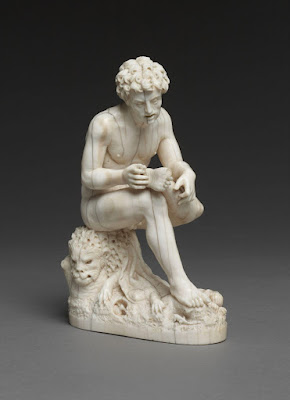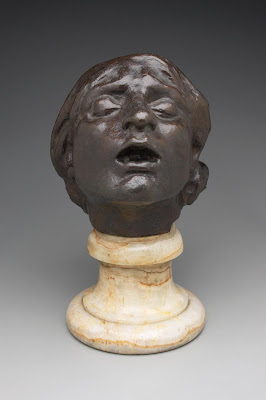 |
| Christoph Weiditz Hercules plucking a thorn from his foot (derived from the antique Spinario) ca. 1540-50 ivory Victoria & Albert Museum, London |
 |
| Ingebrigt Vik The Youth 1913 bronze National Gallery of Norway, Oslo |
 |
| Royal Copenhagen Manufactory Lord Byron 1835 porcelain (after a marble of 1831 by Bertel Thorvaldsen) Victoria & Albert Museum, London |
 |
| Petronio Tadolini The Samaritan Woman 1767 painted terracotta Minneapolis Institute of Art |
 |
| Giovanni Francesco Susini Young St John the Baptist ca. 1610 marble National Gallery of Art, Washington DC |
 |
| Giacomo Serpotta Winged Heads of Three Putti ca. 1690 painted terracotta Nelson-Atkins Museum of Art, Kansas City, Missouri |
 |
| Augustus Saint-Gaudens Head of Mourning Figure (study for memorial to Clover Adams) modeled in plaster, 1892-93 cast in bronze, 1912 Art Institute of Chicago |
 |
| Auguste Rodin Head of Sorrow 1889 bronze Yale University Art Gallery |
 |
| Roman Empire Mars Cobannus AD 125-175 bronze Getty Museum, Los Angeles |
 |
| Roman Empire Torso 1st-2nd century AD marble National Gallery of Norway, Oslo |
 |
| Ivan Meštrović Torso of Strahinja Banović (mythical Serbian hero) 1908 marble Victoria & Albert Museum, London |
 |
| Tilman Riemenschneider Pair of Kneeling Angels ca. 1505 limewood Victoria & Albert Museum, London |
 |
| William Henry Rinehart Woman in Mourning ca. 1860-70 marble Chrysler Museum of Art, Norfolk, Virginia |
 |
| George Rennie Cupid kindling the Torch of Hymen ca. 1831 marble Victoria & Albert Museum, London |
 |
| Auguste Préault Venus and the Sphinx 1868 plaster modello (for garden sculpture at Château de Fontainebleau) Metropolitan Museum of Art, New York |
 |
| Auguste Préault Jupiter and the Sphinx 1868 plaster modello (for garden sculpture at Château de Fontainebleau) Metropolitan Museum of Art, New York |
Our Best Poets, by Theodore Maynard. Henry Holt & Co.
Certain books move one to wonder, not why they were written – for anyone may jog a typewriter – but why they ever secured a publisher. Mr. Maynard's competence, whether as poet or critic, is not yet so authoritatively recognized in his own country as to encourage us colonials to lend him our ears. The value of his utterances may be gauged by his list of the "twelve leading poets," arranged "in their order of merit" as follows:
1st G.K. Chesterton
2nd Alice Meynell
3rd Charles Williams
4th Walter de la Mare
5th Ralph Hodgson
6th W.B. Yeats
7th Hilaire Belloc
8th J.C. Squire
9th W.H. Davies
10th Lascelles Abercrombie
11th Laurence Binyon
12th John Masefield
Mr. Yeats will doubtless be gratified at his inclusion; and Mr. Masefield, arriving by the skin of his teeth at the end of the procession, will hasten to send a letter of thanks.
– from a review by Harriet Monroe printed in Poetry, May 1923